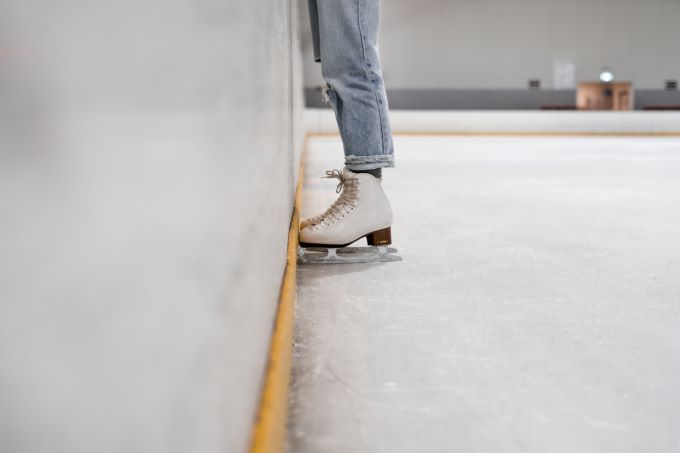Research In Action
Research In Action
Breadcrumb

Every four years after the Winter Olympic Games, there’s a renewed interest in winter sports, including figure skating and ice hockey. A new generation of children, inspired by what they have seen, will step into their local rinks and experience the joys of gliding on a clean sheet of ice. As the rising stars of U.S. figure skating make their entrance at the 2023 Toyota U.S. Figure Skating Championships in San Jose today through Sunday, it’s a good time to alert families and public health agencies about the potential risk of carbon monoxide poisoning within indoor ice arenas.
Often, little attention is given to ice re-surfacers, most commonly known by the name Zamboni®, as they glide by. Many still in use today are fossil-fueled and release combustion products, most notably carbon monoxide, into ice arenas. The configuration of ice rinks with colder air closer to the ice surface and warmer air in the stands leads to trapping of pollutants at ice level.
Exposure to carbon monoxide can poison the body’s ability to use oxygen or make energy, which leads to symptoms similar to cold and flu, including headaches, dizziness, drowsiness, nausea, and vomiting. In severe cases, carbon monoxide poisoning can lead to fainting, coma, seizures, and death. Children are more vulnerable than adults due to their shorter stature and therefore closer proximity to the ice surface, faster rate of breathing, greater overall metabolic demands, and decreased ability to communicate symptoms they may be experiencing.
Last winter the Poison Control Center at Children’s Hospital of Philadelphia received calls about teenage ice hockey teammates who developed headache, nausea and vomiting while competing in a local tournament. They were diagnosed with carbon monoxide poisoning and treated with supplemental oxygen. Seeing a need, we decided to investigate indoor ice arenas as public spaces at increased risk for mass carbon monoxide poisonings.
Tracking Exposures in Pennsylvania and Delaware
Our research of carbon monoxide exposures from indoor ice arenas in Pennsylvania and Delaware, as reported to the Poison Control Centers in Pennsylvania (CHOP and Pittsburgh) from 2012-2021, was presented at the 2022 North American Congress of Clinical Toxicology and the 2022 American Academy of Pediatrics National Conference and Exhibition. We found:
- 29 cases of acute carbon monoxide poisoning were attributed to indoor ice arenas, with 24 cases among children and adolescents (ages 20 months to 18 years with a median age of 13 years) from 7 distinct exposure events.
- Between 1 and 8 children were affected per exposure event.
- All exposure events occurred in the fall and winter and 93% of cases reported occurred between Friday and Sunday.
- Headache, nausea, and dizziness were the most reported symptoms.
- 17 children (71%) were evaluated in emergency departments and demonstrated levels of carboxyhemoglobin (the marker of carbon monoxide in blood) consistent with excess carbon monoxide exposure.
- 17 children were treated with supplemental oxygen and 1 was referred for specialty hyperbaric oxygen therapy, the primary treatment for acute carbon monoxide poisoning.
Multiple carbon monoxide poisonings had also been reported, in the public media, during the same time period in the Pennsylvania and Delaware area.
How To Stay Vigilant
Despite decades of local and national media reports of mass carbon monoxide poisonings in indoor ice arenas, most state legislatures do not regulate carbon monoxide emissions in them. Only those in Massachusetts, Rhode Island and Minnesota do. Without consistent monitoring, unsafe levels of carbon monoxide in indoor ice arenas may continue to be under-recognized. This places children at risk for repeated carbon monoxide exposure, especially in the winter season, when hockey and figure skating are much more popular and large hockey tournaments and figure skating competitions are held.
What Ice Arena Operators Can Do
Ice arena operators can take action to reduce the risk of carbon monoxide poisoning. Using policies from Massachusetts, Rhode Island, and Minnesota as guidance, they should be encouraged to:
- Properly ventilate their facility and monitor the indoor air environment by:
- maintaining working carbon monoxide monitors in public areas
- warming up fossil-fueled ice re-surfacers in a well-ventilated area, outdoors if at all possible
- performing routine maintenance on fossil-fueled ice re-surfacers and their arena’s ventilation system by following product manufacturer guidelines
- Provide training for rink personnel to recognize the signs and symptoms of carbon monoxide poisoning and to understand emergency procedures in the event of suspected unsafe carbon monoxide levels
- Alert the general public to the potential for carbon monoxide exposure within indoor ice arenas by posting signage about the signs and symptoms of carbon monoxide poisoning
- Consider transitioning to electric ice re-surfacer technologies
What Families Should Know
Clinicians should keep in mind that children spending time in indoor ice arenas, as participants or spectators, may be at risk for carbon monoxide poisoning. It’s important to alert parents/ caregivers to:
- Watch for concerning symptoms such as headache, nausea or vomiting, or dizziness during and after visits to ice arenas
- Ask ice arena operators if and how carbon monoxide levels are being monitored and what procedures exist if higher than safe levels are detected
- Look for posted signs that explain the signs and symptoms of carbon monoxide poisoning
- Suggest that facilities post signage if they use fossil-fuel burning ice re-surfacers
These steps can help to ensure that children stay safe while enjoying their time on the ice.
If you suspect that a child is experiencing carbon monoxide poisoning, please call the Children’s Hospital of Philadelphia Poison Help Hotline at 1-800-222-1222 to be connected to a specialist. If the child has fainted, is having trouble breathing, or is having a seizure, call 911.



